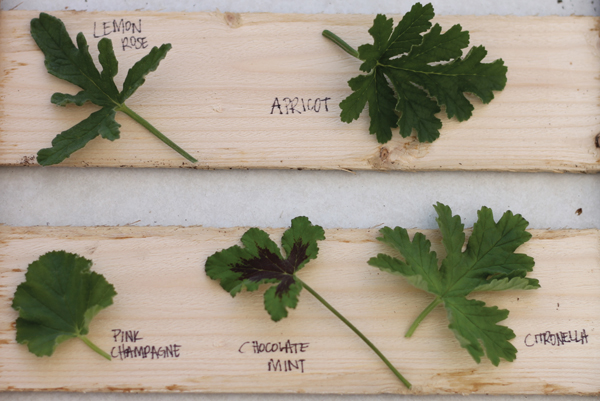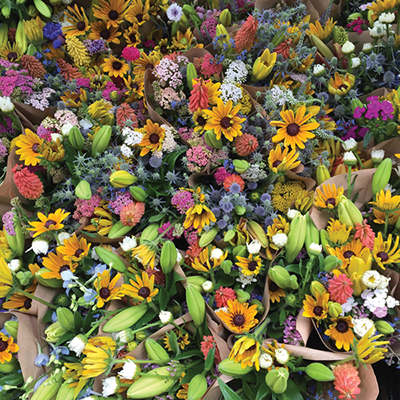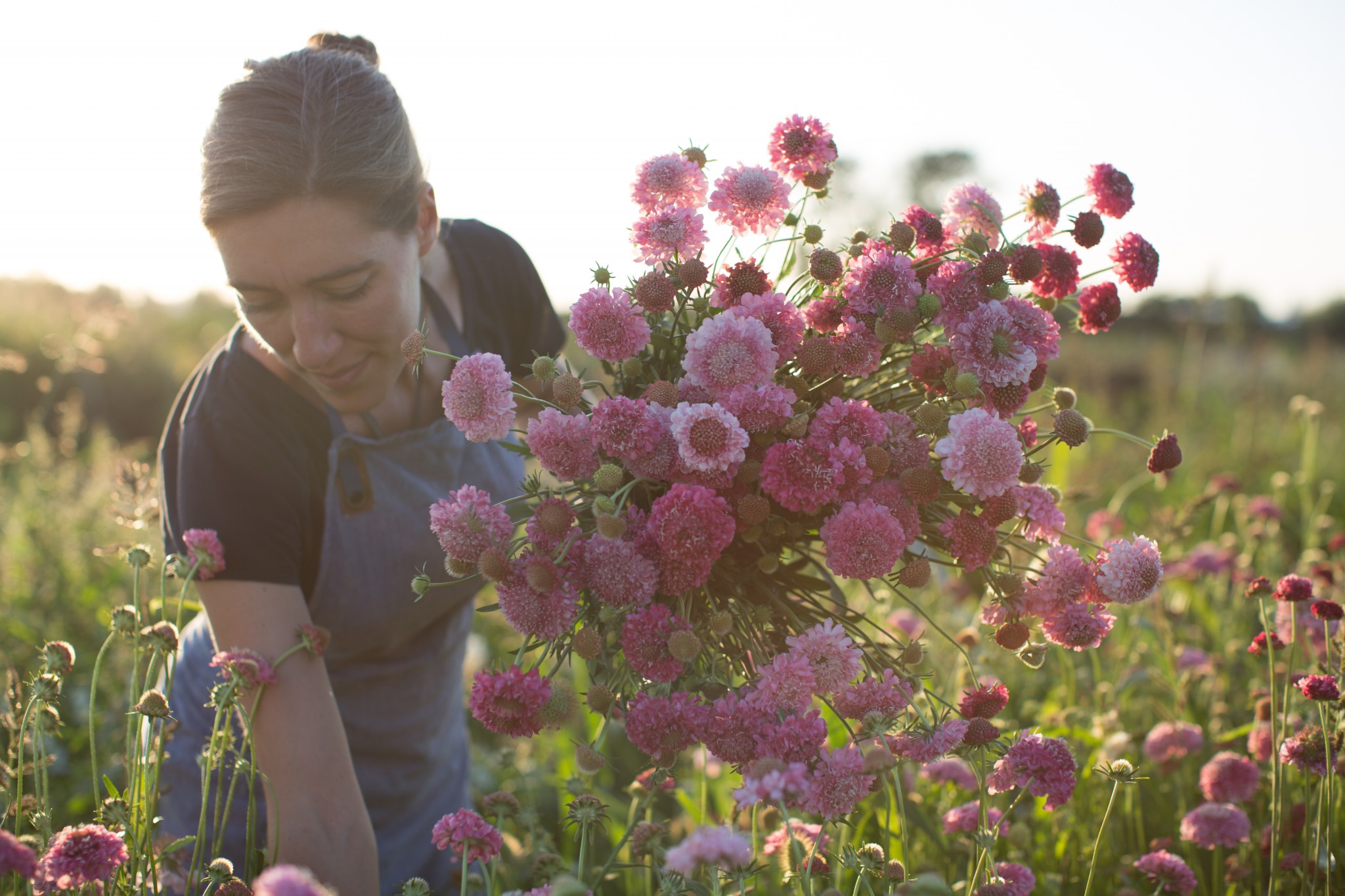This article was originally published in the May 2015 issue of Growing For Market Magazine.
Textural arrangements are popular, especially for wedding and other events, so foliage is definitely an important part of a bouquet. Having creative foliage is something that sets apart a locally grown bouquet from the typical florist bouquet. It gives the customer something unique and gives it a more natural, ethereal look. The attention to detail makes people fall in love with flowers even more.

We grow many plants specifically for foliage, and we consider anything growing in our landscape plantings around the house to be fair game. For the most part, we save foliage for florists and our own events. We don’t use it as much in our wholesale or market bouquets unless the flowers themselves aren’t bulky enough to fill out the sleeve.
As a general rule of thumb, we have found that most foliage needs to be cut directly into a hydrating solution—we use Chrysal OVB — to prevent it from wilting. The stage of maturity at harvest can also be important, as soft, new growth is more likely to wilt than hardened stems.
Our advice is to experiment. If you see something you like, just run some trials to see if it will hydrate and whether or not it should go in the cooler. That’s how we discovered some of these treasures!  Spring foliage
Spring foliage
We always plant a patch of dusty miller in the heated greenhouse to overwinter so we have some for cutting in the spring. It’s great to have available to florists when our first flowers start blooming as an additional crop on the truck. For the overwintering crop. we plant the seeds in Week 26 and transplant them Week 35 to a greenhouse that is heated to 40°F all winter. We plant lots more dusty miller in the spring to harvest later in summer when it has hardened and the stems have become turgid.
As perennials, trees, and shrubs leaf out, our foliage options increase. Some of our favorites: pussy willow, boxwood, plum trees, Japanese maple, and viburnum. We just have to be careful that they haven’t sprouted a new growing tip yet, as the new growth has to harden before the branches will hydrate, and we don’t want our first bouquets of the season to wilt. All of these crops also can be cut later in the season if we miss our first opportunity in spring. I will cut pretty much anything planted around our house. One discovery-turned-love of mine are pear branches with mini pears on them. One year we hadn’t trimmed our Asian pear trees, and we didn’t want to cut them in flower because the blossoms are too stinky to sell. So we waited until the branches had tiny pears on them; we continued to cut them until the pears got too heavy for the branches to support themselves. It was a great solution because the trees were getting managed, and it gave us a fruiting branch like the trendy citrus branches West Coast designers use.
Top, dusty miller is overwintered in a 40°F greenhouse. Above, fruiting pear branches are used for event work. All photos courtesy of Sunny Meadows Flower Farm.
Another thing we discovered last year was how to use viburnum in arrangements. I had hoped to use the snowballs of Viburnum ‘Roseum’, but they bloomed between events and then a downpour destroyed them. We cut the foliage instead and used it. Another accidental discovery was Viburnum carlesii, the Korean spice viburnum. I cut some as a trial, but accidentally left it sitting out of water overnight, and it looked fine the next day without ever being hydrated. This has become our go-to foliage for the base of a wrist corsage, or something that is going to be in the sun for an event.
Summer
Scented geraniums are a big producer for us through the summer. They can go in a high tunnel or in the field, and we use them for events and everyday bouquets. We use a lot in our wedding work, especially my personal favorite, ‘Pink Champagne’. We got this variety from a retiring herb grower, and I haven’t been able to find it anywhere else, so we treasure our stock plants. We hope to sell geranium cuttings in the future, and are now looking into the certification necessary. Other scented geranium varieties we like in order of how much we use them are: Lemon Rose, Apricot, Citronella, and Chocolate Mint. Some of the wider-leafed varieties tend to get a little wilted in the sun, so be careful with the latter two for summer event work. Eucalyptus lives through the winter in an unheated high tunnel in our zone, 6a. We started it from seed about five years ago and it is a slow grower at first, but once it is established, it will really take off each season.

Above: Steve Adams harvests scented geraniums; below, Gretel’s favorite varieties
Now we also have some in 3-gallon pots we plan to leave in heated space, but keep mobile so they can go outside during the summer. This will help increase production without taking up any more valuable bed space in the tunnels.
Besides some of the woodies mentioned before, other landscape plants work for cutting: Lamb’s ear, Boxwood, Heuchera, Coleus, Smokebush, Ferns, and Magnolia. We don’t have many of these around, so they are reserved for special events, foraged for a lucky bride. Or if I need something specific that I don’t grow, I will buy a finished plant from a local nursery, cut it up, and then plant it for next year’s use.

Other things we like to use in the summer are branches from our berry plants, especially if they have green or barely ripening berries. Physocarpus, commonly called Ninebark, is another useful shrub. We also use our curly willow with the foliage throughout the summer. We can’t sell bunches of curly willow branches in the fall/winter because of a local landscape company filling the market, so we just try to use them for other purposes. Any of the willows are great for wreath bases.
Autumn
We love all the grasses for foliage and also for their seeded plumes or heads that appear in fall. Some of our favorites are Northern Sea Oats (Chasmanthium latifolium) and Panicum ‘Frosted Explosion’. Grasses add such movement to event work and are something that is not seen everyday. We are trying Eragrostis ‘Ruby Silk’ grass this year, and are always looking for new interesting grasses for texture. We also use Miscanthus, both for the foliage and also for its plumes—we call it “glam grass”. We also use several millets and sorghums.
We love to use vines to give a little bit of cascade to a bouquet or arrangement. Some of our favorites in fall are hops, clematis, and love-in-a-puff (Cardiospermum halicacabum), but be aware that is considered invasive in some states.
Ornamental cabbage is great for use in late fall/early winter when you need something big to fill arrangements. The longer you leave it in the ground with cold weather, the more the color develops. We also like ‘Black Pearl’ ornamental peppers because the foliage of this specific variety stays hydrated and gives you rich, dark color. And sometimes we use fall leaves once they have started to turn color, a great way to incorporate the season into a wedding.

Above: The ornamental grass ‘Frosted Explosion’ adds movement and texture to summer and fall designs.
Grapevine works well for a larger install such as an arbor or entranceway. The foliage does not stay hydrated for long, so we cut it right before it is to be used and place the end of the stem in a bucket. If the foliage is damaged, sometimes we cut it off and just use the vine itself.
Weeds
Above: Foliage is an essential component of many bridal bouquets. While dahlias are the stars in this design by the author,
it’s the multiple types of greenery that provide texture and movement.
Pokeweed is one of my favorite plants. The foliage works in arrangements, but what I really love is all the stages the flower goes through as it turns into berries. It starts out as little white flowers with a pink hue, and then gets little green berries before they start to ripen. We don’t use them once they are fully ripe because they will stain everything!
Hobby plants
We keep a few things in the greenhouse just for those extra-special arrangements. Really, I think it may be our excuse to hoard plants, but I’ll take it! Steve takes great care of our collection of begonias, ferns, and ivies. These are all recent obsessions of mine that we work into arrangements, plus an Agonis tree I cut from. We have planted some ivy in hanging baskets to keep in the greenhouse so I can have long pieces for arbors or other wedding installs, or for sale to florists if there is extra. We got the ivy plants from a retiring farmer and aren’t entirely sure of the cultivars. Some are solid, some variegated, and all are useful.
Gretel and Steve Adams own Sunny Meadows Flower Farm in Columbus, Ohio. Gretel is a regular contributor to Growing for Market.










 Lorna Jackson started flower farming intensely relatively later in life at Ninebark Farm on a century-old hayfield in Metchosin at the southern tip of Vancouver Island in British Columbia, Canada. Now 64, she plans to continue into her 70s. To keep going, she makes adaptations to ease the toll on her body.
Lorna Jackson started flower farming intensely relatively later in life at Ninebark Farm on a century-old hayfield in Metchosin at the southern tip of Vancouver Island in British Columbia, Canada. Now 64, she plans to continue into her 70s. To keep going, she makes adaptations to ease the toll on her body.


 Marketing is the other half of the battle
Marketing is the other half of the battle



